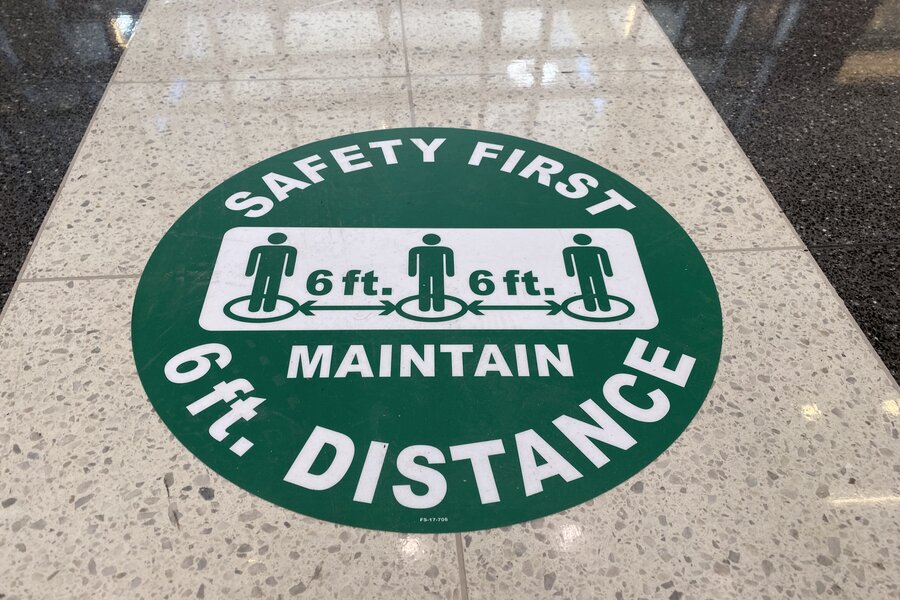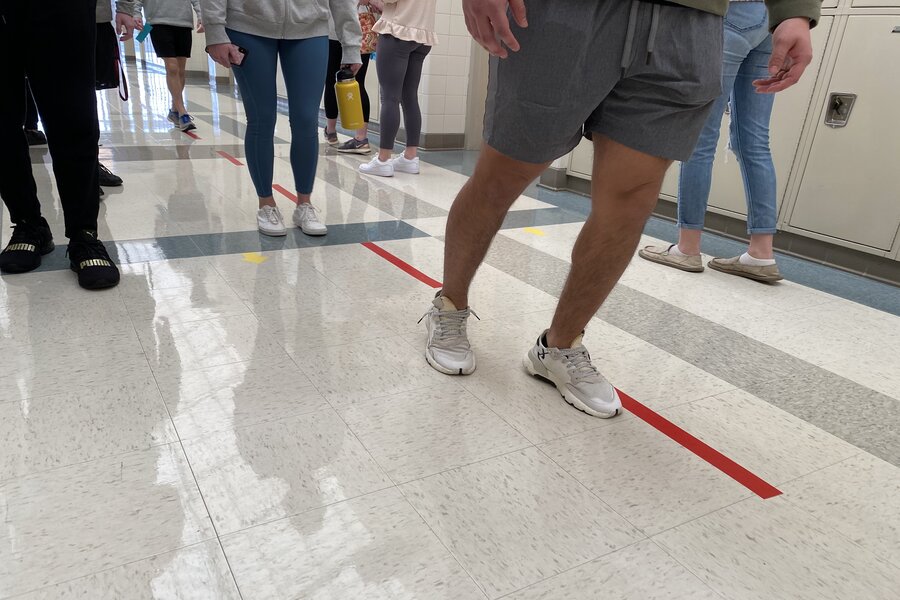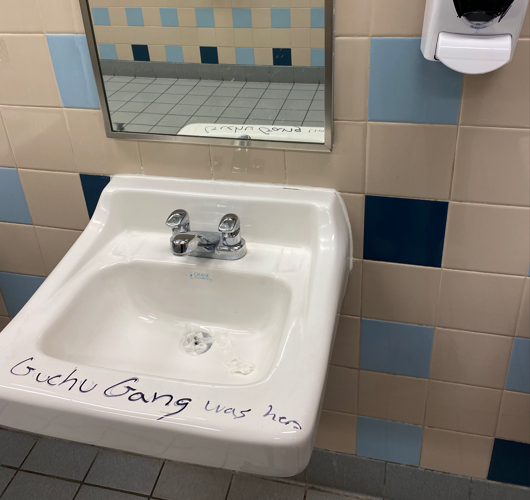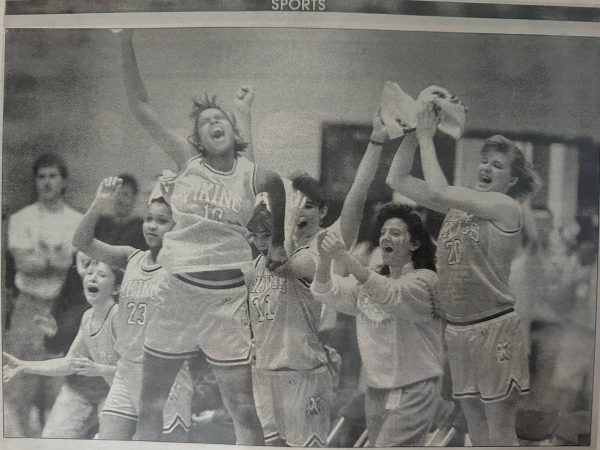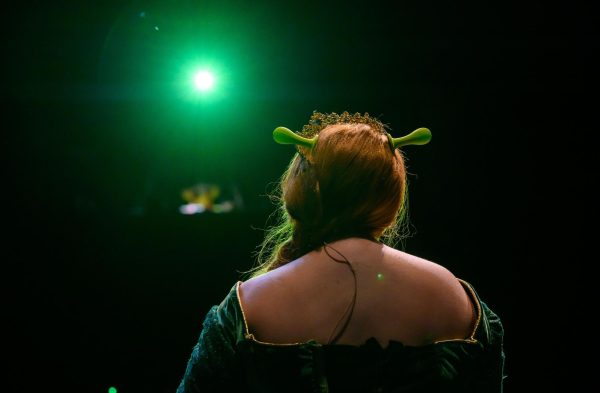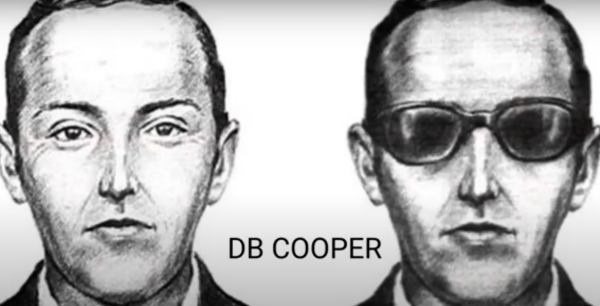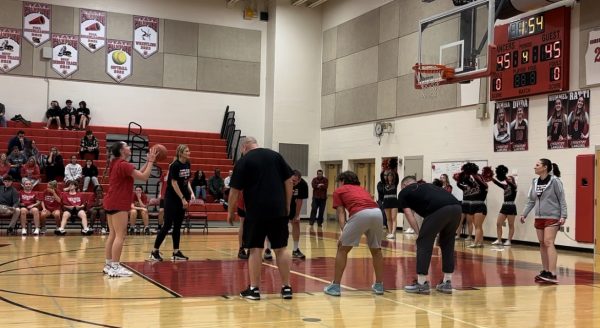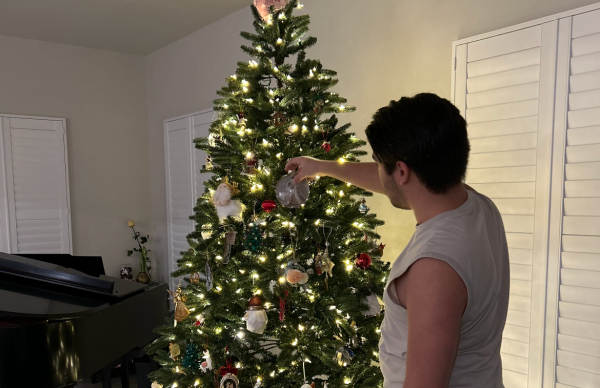Sanitization and Separation: A day in the life of an in-person hybrid student
These green stickers are across the whole school, making sure that students are socially distanced.
March 5, 2021
A student ritualistically checks the loops of their double-layered, CDC-approved face mask once more before slinging their backpack over their shoulder. They douse their hands in sanitizer, the burning smell one that has become achingly familiar over the past months. Rising from their assigned bus seat, the student mentally prepares for the long-awaited reunion with their beloved high school and the mask-clad teachers and peers within.
On February 16, the above situation became a reality for Frederick County Public School’s Cohort A students, as they joined staff at school buildings for hybrid in-person instruction for the first time since March 2020.
“I knew it would be weird going back but it was still nice to be in school again, especially to see all of my friends and teachers that I have not seen since almost a year ago,” said sophomore Dan Golemboski.
Upon arrival, it was immediately apparent that the school students were returning to hardly resembled the educational and social environment they had left behind at the beginning of the COVID-19 pandemic, as heightened safety is now a constant concern.
“As long as all students and all staff follow the safety procedures, we will all be safe. Students have been good about masking, but distancing seems harder for students to maintain,” said biology teacher Beth Ericsson.
Students begin their days by traversing, in accordance with the directional arrows on the floor, the eerie quietude of the once-teeming-with-life Main Street. They are instructed to head directly to class to reduce the risks derived from the large gathering sizes and social congregations that typify high school hallways.
“I used to like hanging out and talking in a group with my friends before the bell rang in the morning, it’s just kind of sad to see the hallways so empty now,” said Golemboski.
Once in their classrooms, students collect their paper placemat, to be used as a desk covering and then disposed of at the end of each period. Throughout class time, eating and drinking has been eliminated to promote consistent mask-wearing, and a Google Form hallway sign out allows for efficient, building-wide contact tracing.
“I have now become, among other things, the mask police, the table cover guardian, and the social distancing representative of the classroom. Students are not aware of the dangers, or just don’t feel in peril,” said teacher Scott Stair.
After being seated at their individual desks (apart from other students and permanently assigned for the rest of the year), instruction for students can begin. However, just because part of the class is located in the physical classroom, smooth instructional sailing for teachers is not guaranteed, as they are required to accommodate virtual and in-person learners simultaneously.
“I am careful to make sure that my virtual students are able to see me and learn the curriculum. My in person students are able to see me, that’s a given. I want all my students to have equitable experiences,” said Ericsson.
Not only does the hybrid method of teaching slightly hinder the flow of general classroom function, but hands-on electives must also make changes due to a continued inability to handle their tools and materials to complete projects safely.
“No students near my desk, air purifier strategically placed, and lab stations vacant and unused. Equipment cannot be cleaned in a timely fashion, so new virtual forms of labs must be established… There are no demos, which I love to perform and discuss. The teacher student conversations are gone. And the ability to inflect humor into the classroom is minimal. I have become way more patient with student questions and my technological patience has improved,” said Stair.
Aside from classroom procedures, awkward discomfort persists during lunch time. Students file into the cafeteria to seat themselves once more at lone, distanced desks, a social scene that differs greatly from the bustling tables that once filled the room.
“Lunch is pretty quiet now but it is still good to have a break in the middle of the day. Not sitting together at tables feels weird though because it doesn’t feel like lunch, just like being in a classroom with a bunch more people,” said Golemboski.
After completion of their school day, students are dismissed in staggered groups for reduction of hallway congestion, to obtain their free bagged supper (one of three no-cost meals offered during the school day) and exit the building. They then return home to work independently for the remainder of the afternoon, a schedule devised to accommodate all types of hybrid learners.
“It’s harder to teach in my natural style. The classes are shorter, it’s harder to do things, everything is different. Letters that I receive from graduates invariably thank me for the life lessons that they’ve learned from me, in addition to the Biology; I don’t feel that I am able to convey the life lessons along with the Biology that I normally teach with the shortened time and being virtual. This saddens me and I miss the greater sharing that was possible in the before times,” said Ericsson
The Cohort A students then repeat this process once more, before remaining virtual for the rest of the week as the building is sanitized fully on Wednesdays in preparation for the arrival of Cohort B students on Thursdays and Fridays.
“The custodians do a phenomenal job with daily disinfecting of the classrooms. That part is huge,” said Stair.
Much remains to be determined in terms of the effectiveness of these procedures, the progression of hybrid learning, and the future of FCPS education. Regardless, it is clear that leaning in to the uncomfortable abnormalities now is the first step towards true normalcy later.
“All of the COVID procedures, masking, distancing, and hand-hygiene, are extremely important for keeping everyone safe. The procedures could be a matter of life and death for not only students and staff but our families as well. It is vitally important that we all follow COVID procedures. Even though the metrics are currently greatly approved from the peak, it is not time to relax from following COVID procedures; they are what will continue to keep us safe, especially in light of the COVID variants,” said Ericsson.


